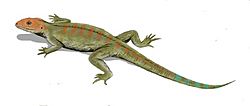Hylonomus facts for kids
Quick facts for kids HylonomusTemporal range: Pennsylvanian, 315–312 mya
|
|
|---|---|
 |
|
| Life restoration of Hylonomus lyelli | |
| Scientific classification | |
| Kingdom: |
Animalia
|
| Class: |
Sauropsida
|
| Type species | |
| †Hylonomus lyelli |
|
Hylonomus was a small, ancient creature that lived about 312 million years ago. It was one of the earliest known reptiles. Imagine a tiny lizard-like animal scurrying around ancient forests!
Contents
Meet Hylonomus: An Ancient Reptile
Hylonomus was an early four-legged animal. It lived during a time called the Pennsylvanian period. This was long before dinosaurs roamed the Earth. Scientists sometimes find it tricky to classify very old fossils. Hylonomus had a skull that makes it hard to be absolutely sure if it was a true reptile or something very close to it.
What Did Hylonomus Look Like?
Hylonomus was about 20 centimeters (8 inches) long, including its tail. This is about the length of a common pencil! It probably looked a lot like modern lizards.
It had small, sharp teeth. This suggests it was a carnivore, meaning it ate meat. Hylonomus likely hunted and ate small invertebrates. These would have included creatures like millipedes or early insects.
Where Were Hylonomus Fossils Found?
Most Hylonomus fossils have been found in Nova Scotia, Canada. They were discovered in a place called the Joggins Fossil Cliffs. This area is famous for its many ancient plant and animal fossils.
The fossils were found inside the remains of ancient club moss stumps. Scientists believe that after big storms, these tall club mosses would fall over. Their stumps would then hollow out. Small animals like Hylonomus, looking for shelter, might crawl inside. Sadly, they could get trapped and not be able to get out. This is how their bodies became fossilized over millions of years.
Other ancient animals have also been found in the same area. These include early reptiles like Archaeothyris and Petrolacosaurus.
Footprints from the Past
Scientists have also found fossilized footprints that might belong to Hylonomus. These footprints are even older, from about 315 million years ago. They were discovered in New Brunswick, which is another part of Canada. These tiny tracks give us clues about how Hylonomus moved around its ancient world.
Images for kids
See also
 In Spanish: Hylonomus para niños
In Spanish: Hylonomus para niños


